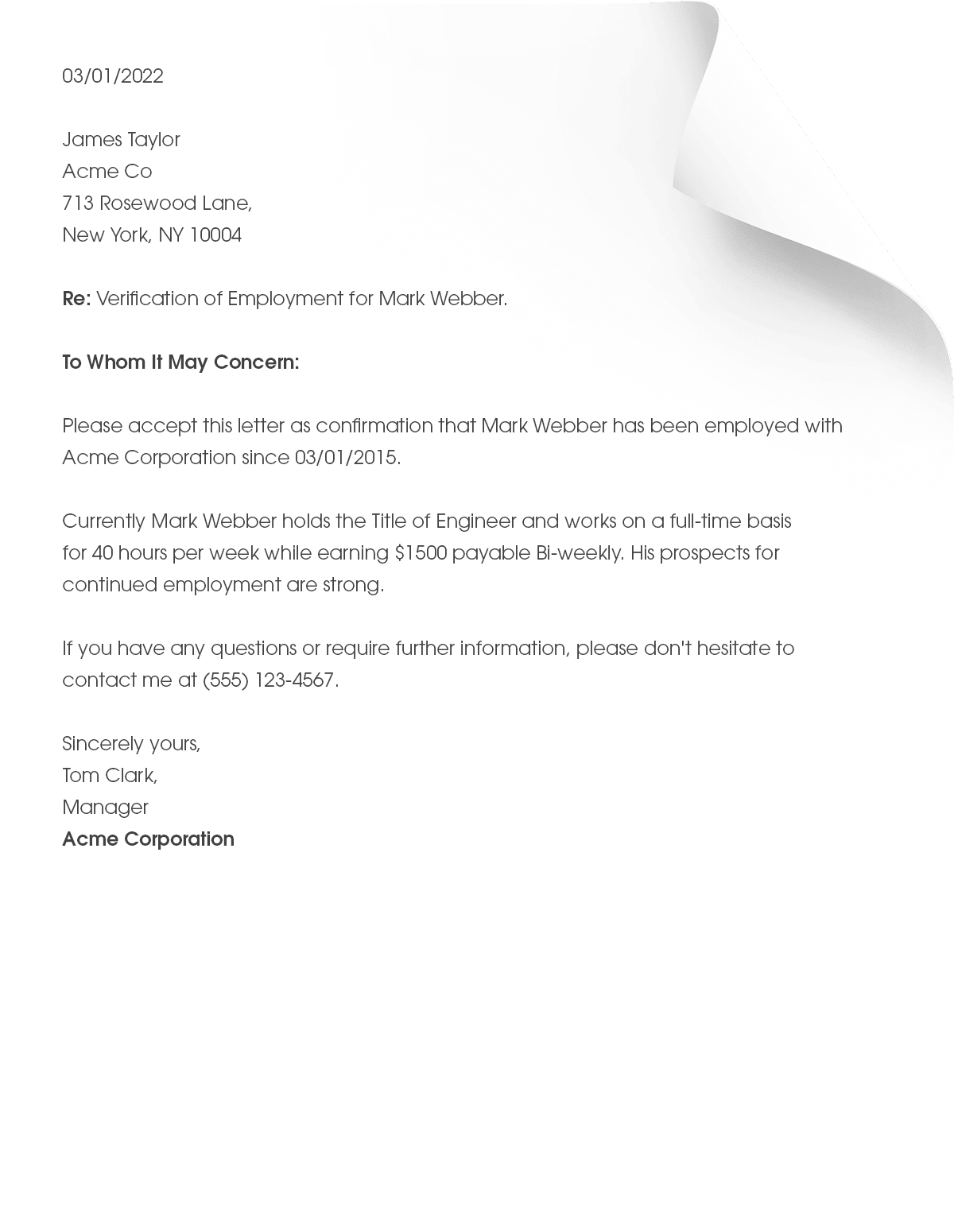What is an Employment Verification Letter?
An employment letter is a document written by a current or past employer that confirms the employment status of a former or current employee at an organization. An Employment Verification Letter may also be referred to by various alternate names, including:
- “Verification of Employment Letter”
- “Employment Confirmation Letter”
- “Proof of Employment Letter”
- “Job Verification Letter”
- “Work Verification Letter”
- “Employee Verification Letter”
- “Letter of Employment Verification”
- “Employment Reference Letter”
- “Employment Certification Letter”
- “Employment Status Letter”
It can be requested by the employee, prospective employers, or various other governmental agencies and financial institutions. An employment verification letter also verifies the employee’s dates of employment, job title, previous salaries, and their eligibility to be rehired. The person or institution requesting the verification of employment letter may also ask for reasons why the employee’s previous contracts were terminated.
Why Are Employment Verification Letters Necessary?

There are several reasons why a current or former employee could request an employment letter. Here are the most common reasons:
- The person is applying for a mortgage or car loan and the lender wants to confirm that they have a steady income to cover monthly payments.
- The person is applying to rent a home and the real estate company wants to make sure that they can afford the deposit, monthly rent, and other costs.
- The person may be requesting a loan payment reduction and the bank needs to see proof of income before they can approve the request.
- If the person is applying for a new or different job, the prospective employer may need proof of employment along with verified personal information.
Employees don’t always need to explain why they’re requesting a verification letter. However, they must be honest about the personal information they submit to the other party. Presenting inaccurate information in your employment confirmation letter can lead to a number of problems. This can include:
- Losing your professional reputation and credibility.
- Facing up to 6 months in jail for being dishonest about something like military experience, for example.
- Companies could sue you if your inexperience ends up causing damages.
- You could also lose legal protection if you choose to sue an employer for discrimination.
Salary History Bans and Employment Verification
Salary history checks are inquiries made by employers to learn about a job candidate’s past earnings at previous jobs. These checks can be done by asking the candidate directly, contacting former employers, or reviewing official documents like pay stubs or W-2 forms.
Some states have started banning salary history checks. This means that people who submit employment verification requests aren’t allowed to ask you to include your previous salary information, bonuses, or raises.
Although it’s illegal to pay men and women different salaries for the same job, the gender pay gap still exists in many companies. By not showing potential employers what you’ve earned in the past, they might make you a fairer job offer based on your skillset rather than gender. This means that a prospective employer is also unable to rely on your previous salary details to determine your compensation.
There are currently 22 states in the U.S. that ban salary history checks.
What Should Be Included in an Employment Verification Letter?
The information you need to include in a verification letter depends on the person or financial institution, as well as the specific state requirements. When writing an employment verification letter, you should include the following basic information:
- Employer address
- Company name and address
- Employee name(s) and surname
- Employment dates
- Former or current job title and description
- Employment history
- A former employee should include eligibility for rehiring
- Employee current salary, raises, and bonuses (if applicable)
- Reason for termination (if applicable)
Current staff members must make sure that they format the verification letter to confirm that they currently work for the company. It’s also important to check with the requester if they prefer a digital or physical copy of the employment verification letter.
What Are the Most Common Mistakes to Avoid?

When writing an employment verification letter, it’s important to make sure that it looks professional. Two of the most common mistakes people make are including irrelevant information and presenting it in the wrong format. Below, we have included some tips to ensure that you avoid the same mistakes.
1. Follow an Employment Verification Letter Template
– An employment verification letter template is often the same as a standard business letter. This ensures that you follow a set format and the correct guidelines.
– Make sure that you include the date and the contact information of the recipient, if applicable.
– It’s also important to add a professional greeting at the beginning of the letter and sign off with a handwritten signature.
2. Include All of the Requested Information
– Generally, an employment verification template includes the employee’s name, which department they worked in or their specific job title, as well as the length of their employment.
– Be sure to check with the requester whether they require any additional information.
– This may include information about employment dates, how many hours the staff member worked per week or month, and what their payment cycle was.
3. Keep the Letter to the Point
– When you write an employment verification letter, don’t add information that’s not relevant to the request.
– A proof of employment letter is typically only about 50 to 100 words long.
4. Include Your Contact Details
– Offer to answer any further questions at the end of the letter and remember to include a preferred method of communication in your contact details.
5. Edit and Proofread the Letter
– The professionalism of the letter should be your top priority. This is because the individual’s future employment, house, or insurance may depend on how it’s perceived.
– Make sure that you put enough time aside to read through the letter and correct any mistakes.
How Do I Verify an Employment Verification Letter?
An employment verification form is one of the last steps that most financial institutions and businesses take to protect themselves against false claims. This is why proof of income documents will also be requested along with an employment verification letter.
Here is a list of documents that can be accepted as proof of income:
- Pay stubs
- Tax returns (1040)
- Wage and tax statements (W-2)
- Social Security proof of income
- A workers’ compensation letter
- Bank statements
A public officer will also be able to verify your income with a certified stamp to confirm that the information is authentic.
Self-employed individuals are also required to submit proof of income. In addition to an employment verification letter, the following will be accepted:
- IRS Form: 1099-MISC
- Tax returns
- Bank statements
Do I Need a Lawyer, Accountant, or Notary to Help Me?

You can easily create an employment verification letter sample without hiring a lawyer, accountant, or notary.
Creating the form online can save you time and money. It can also minimize errors and ensure that the letter looks professional compared to writing it without a template.
What is the Easiest Way to Create an Employment Verification Letter?
At FormPros, we have developed an efficient and convenient solution to creating an employment verification form online.
With us, it’s not necessary to spend hours learning how to write an employment verification letter. This is because our software will help you to create an employment letter template in a matter of minutes.
Rest assured that your sensitive information is in safe hands. FormPros employs state-of-the-art security measures to protect your data at every step of the process.
Why use our Employment Verification Letter generator?
- Easy to use
- Eliminates mistakes
- 100% money-back guarantee
- 100% private and secure
- Legally binding documents
FormPros doesn’t require the installation of additional software, which will save you even more time and money.
Create An Employment Verification Letter Now
Simplify your paperwork with FormPros! From creating paystubs, W-2s, and 1099-NEC forms to generating LLC Operating Agreements and even voided checks, our easy-to-use platform has you covered. Save time, reduce errors, and handle your business documents with confidence. Start now and see how FormPros makes professional form generation fast, affordable, and hassle-free!
Employment Verification Letter FAQs
-
What is the purpose of a proof of employment document?
A proof of employment document serves to confirm an individual's current or past employment status with a particular company or organization.
-
How does an employment verification letter differ from a proof of employment document?
While both serve to confirm employment status, an employment verification letter is typically a formal document provided by an employer directly to a requesting party, whereas proof of employment may encompass various documents such as pay stubs, tax records, or offer letters.
-
Can an employment verification letter be used for purposes other than confirming employment?
Yes, an employment verification letter may also be required for tasks such as applying for a loan, renting an apartment, or obtaining a visa.
-
Who typically requests an employment verification letter?
Requests for employment verification letters commonly come from prospective landlords, financial institutions, government agencies, or potential employers.
-
What information is usually included in an employment verification letter?
An employment verification letter typically includes the employee's name, job title, dates of employment, and salary information (if requested). It may also state whether the employment status is current or past.
-
How long does it usually take for an employer to provide an employment verification letter?
The timeframe for obtaining an employment verification letter varies depending on the employer's policies and procedures. It could range from a few days to a couple of weeks.
-
Is there a standard format for an employment verification letter?
While there isn't a strict standard, most employment verification letters follow a similar format, including the employer's letterhead, contact information, a statement of verification, and relevant employee details.
-
Can an employee request their own employment verification letter?
Yes, employees can request an employment verification letter from their employer for personal use, such as applying for a mortgage or leasing a property.
-
Are there any legal obligations for employers to provide employment verification letters?
In most jurisdictions, there are no specific legal requirements mandating employers to provide employment verification letters. However, many employers choose to provide them as a courtesy and to maintain good relations with employees.
-
Can an employment verification letter be provided for a self-employed individual?
Yes, self-employed individuals may provide documentation such as tax returns or client contracts to verify their employment status.
-
Are employment verification letters confidential?
Employment verification letters typically contain sensitive information about an individual's employment, so employers should handle them with confidentiality in mind. However, the exact level of confidentiality may vary depending on the employer's policies and the nature of the request.
-
Can an employment verification letter be used as proof of income?
While an employment verification letter may include salary information, it is not always sufficient as standalone proof of income. Lenders or other entities may require additional documentation such as pay stubs or tax returns.
-
Is there a fee associated with obtaining an employment verification letter?
Employers usually provide employment verification letters free of charge to current or former employees. However, some third-party services may charge a fee for expedited verification services.
-
Can an employer refuse to provide an employment verification letter?
While it's uncommon, some employers may have policies in place that restrict or prohibit the issuance of employment verification letters. However, this is usually an exception rather than the norm, and employers typically provide them upon request.
-
How long is an employment verification letter valid?
There's no set expiration date for an employment verification letter. However, for certain purposes like applying for a mortgage or loan, lenders may require a letter dated within a specific timeframe, typically within the last 30 to 90 days.





